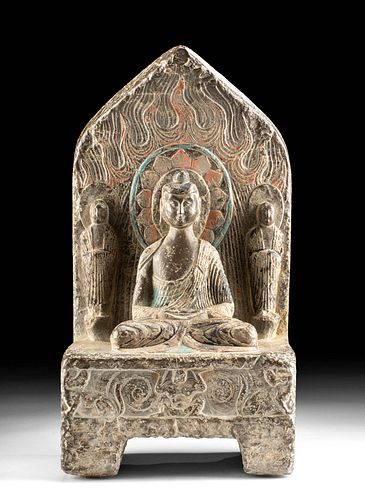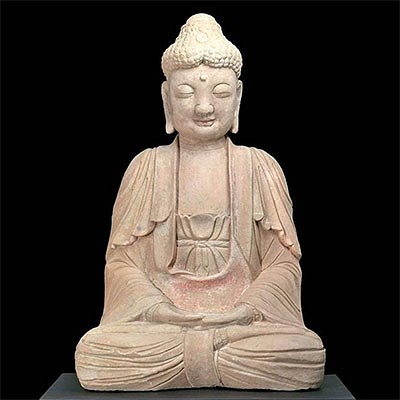Chinese Qi Limestone Stela w/ Buddha & Bodhisattvas
Lot 78
About Seller
Artemis Fine Arts
686 S Taylor Ave, Ste 106
Louisville, CO 80027
United States
Selling antiquities, ancient and ethnographic art online since 1993, Artemis Gallery specializes in Classical Antiquities (Egyptian, Greek, Roman, Near Eastern), Asian, Pre-Columbian, African / Tribal / Oceanographic art. Our extensive inventory includes pottery, stone, metal, wood, glass and textil...Read more
Categories
Estimate:
$16,000 - $24,000
Absentee vs Live bid
Two ways to bid:
- Leave a max absentee bid and the platform will bid on your behalf up to your maximum bid during the live auction.
- Bid live during the auction and your bids will be submitted real-time to the auctioneer.
Bid Increments
| Price | Bid Increment |
|---|---|
| $0 | $25 |
| $300 | $50 |
| $1,000 | $100 |
| $2,000 | $250 |
| $5,000 | $500 |
| $10,000 | $1,000 |
| $20,000 | $2,500 |
| $50,000 | $5,000 |
| $100,000 | $10,000 |
| $200,000 | $20,000 |
About Auction
By Artemis Fine Arts
Feb 18, 2021
Set Reminder
2021-02-18 10:00:00
2021-02-18 10:00:00
America/New_York
Bidsquare
Bidsquare : Exceptional Antiquities, Asian, Ethnographic
https://www.bidsquare.com/auctions/artemis-gallery/exceptional-antiquities-asian-ethnographic-6373
Museum-worthy examples of Egyptian, Greek, Roman, Etruscan, Near Eastern, Far East / Asian, Pre-Columbian, African / Tribal, Oceanic, Native American, Spanish Colonial, Russian, Fossils, Ancient Jewelry, Fine Art, so much more! Artemis Fine Arts info@artemisgallery.com
Museum-worthy examples of Egyptian, Greek, Roman, Etruscan, Near Eastern, Far East / Asian, Pre-Columbian, African / Tribal, Oceanic, Native American, Spanish Colonial, Russian, Fossils, Ancient Jewelry, Fine Art, so much more! Artemis Fine Arts info@artemisgallery.com
- Lot Description
East Asia, China, Six Dynasties Period, Northern Qi Dynasty, ca. 550 to 577 CE. A gorgeous carved-limestone stela featuring a seated Buddha flanked by two bodhisattvas before an intricate backdrop that gently tapers and curves outward at the top, all painted in lovely hues of salmon pink, sky blue, and black. Sitting cross-legged in padmasana (lotus posture) on an integral plinth, the divine figure is draped in a loose robe that falls down his tranquil figure in pleated folds, leaving his right chest and arm partially exposed. His serene countenance projects exaggeratedly forward presenting a petite, close-mouthed grin, a noble nose, and two slanted, squinting eyes under an arched brow. Two long ears, referencing the wealth of Prince Siddhartha before he became enlightened, flank his peaceful visage and an ushnisha caps his head. His hands rest calmly in his lap, held open in abhaya (absence of fear) mudra. Depicted smaller in scale than the Buddha, the bald bodhisattvas stand behind their master, also wearing robes and holding their hands together. Size: 7.25" W x 14.25" H (18.4 cm x 36.2 cm)
Ovoid embellishments are carved in relief behind their heads, while a much larger oval filled with a lotus flower crowns the head of the Buddha and a skillfully incised design of undulating striations resembling flames decorates the background. The rectangular base is supported by two feet and is adorned with an ornate relief featuring a central, muscular figure positioned as though he is holding up the stela flanked by two sizable dogs. Each side of the base is incised with a lovely wavy motif.
Bodhisattvas are among the most compassionate beings in the universe, devoting themselves to saving the suffering and helping others achieve enlightenment and Buddhahood. Traditionally depicted as less austere than Buddhas with graceful postures and elegant garments, a nod to the riches of the Northwestern Chinese Silk Road, this piece is no exception. Bodhisattvas or Guanyin are associated with compassion and mercy - their long ears significant, because they rescues all human beings by hearing their cries for help and the sounds of suffering.
Around the 1st century CE, Buddhism came to China along the Silk Road from India; it brought with it an entirely new visual and artistic iconography. The northern rulers of China in the mid-1st millennium CE sponsored the creation of much beautiful and artistically distinct Buddhist artwork. This example is characteristic of the sculpture produced in Shandong province, northeastern China. The discovery in 1996 of over 400 Buddhist sculptures - broken heads and hands, and hundreds of intact torsos, many with gilding and paint still in good condition - in a field that was once the site of a Buddhist monastery in Qingzhou has allowed archaeologists to understand the artwork of this time period much better. The Qingzhou discovery was the largest known group of such sculptures, but other small caches have been found since the 1970s elsewhere in northeastern China. Fascinatingly, most of these sculptures were made during the Northern Qi period, but were buried - based on coins found alongside them - in the 12th century CE, six hundred years later. This seems to have been done to protect the beautiful artwork from the Qi period from anti-Buddhist sentiment.
Provenance: private New York, New York, USA collection, acquired 1980s to 2000s
All items legal to buy/sell under U.S. Statute covering cultural patrimony Code 2600, CHAPTER 14, and are guaranteed to be as described or your money back.
A Certificate of Authenticity will accompany all winning bids.
We ship worldwide and handle all shipping in-house for your convenience.
#162155Missing foot and part of plinth of attendant on left side. Expected surface wear as shown with nicks/chips, abrasions, and softening of details commensurate with age. Four small felt pads on bottom of base. Otherwise, excellent and intact with nice remaining pigments and light earthen deposits in recessed areas.Condition
- Shipping Info
-
All shipping is handled in-house for your convenience. Your invoice from Artemis Gallery will include shipping calculation instructions. If in doubt, please inquire BEFORE bidding for estimated shipping costs for individual items.
-
- Buyer's Premium



 EUR
EUR CAD
CAD AUD
AUD GBP
GBP MXN
MXN HKD
HKD CNY
CNY MYR
MYR SEK
SEK SGD
SGD CHF
CHF THB
THB















